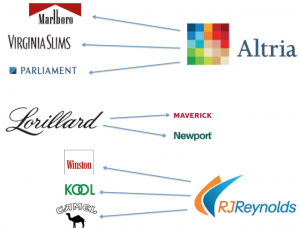Despite the existence of an anti-smoking campaign that “is a major public health success with few parallels in the history of public health,” American tobacco companies continue to dedicate billions of dollars towards cigarette advertisement campaigns.

In the United States, three companies own and control the majority of cigarette manufacturing. Altria is the parent company of Philip Morris USA, which is the corporate entity behind popular brands such as Marlboro, Virginia Slims, Parliament, and Players. Alongside Altria are the R.J. Reynolds Tobacco Company and the Lorillard Tobacco Company – owners of popular brands including Camel, Kool, Newport, and Maverick. While there are smaller tobacco producers in the United States, these three firms control the biggest brands that are coveted by the American consumer.
To market their cigarettes both domestically and abroad, the U.S. tobacco industry dedicates exceptionally large amounts of money towards advertisement campaigns. In 2005, the “U.S. tobacco industry spent $13.5 billion on tobacco advertising and promotion,”[1] while in 2006, the “five largest cigarette manufacturers spent a total of $12.49 billion to promote and advertise their products.”[2] Evidently, in a competitive marketplace, each firm is willing to engage in significant congressional lobbying and expenditure to capture a significant portion of American cigarette consumers.
Then vs. Now
In the early decades of the 20th century, these “tobacco titans” were not plagued by extensive regulation and restrictions on what and where they could advertise. Nowadays, cigarette manufacturers are forced to alter their behavior and expenditure to satisfy current regulations in place. “In response to the changing regulatory climate, tobacco firms are exploring new ways to promote their products.”[3] Firms have dramatically changed their expenditure patterns, and have shifted their focus towards spending on traditional print advertisements and promotional activities instead of television and radio ads.
Surprisingly, the implementation of increased rules and regulation has done little to slow the efforts of tobacco advertisements, as “since 1981, as cigarette consumption in the United States have declined, tobacco industry expenditure on advertising and promotion have grown 10 times greater.”[4] Even though the general public understands the health effects of cigarettes, these companies push even harder to lure in potential customers, and maintain current sales levels.
Currently, the FTC is reviewing a merger proposal that would see R.J. Reynolds and Lorillard become a massive single corporation. If the merger is approved, (50%-80% likelihood) this could be a dramatic shift in the tobacco production industry.
(See Forbes for more details on the Lorillard-Reynolds Merger)
[1] National Cancer Institute. The Role of the Media in Promoting and Reducing Tobacco Use. N.p.: CreateSpace Independent Platform, 2012. Print.
[2] “Tobacco Industry Marketing.” American Lung Association. N.p., n.d. Web. <http://www.lung.org/stop-smoking/about-smoking/facts-figures/tobacco-industry-marketing.html>.
[3] [4] National Cancer Institute. The Role of the Media in Promoting and Reducing Tobacco Use. N.p.: CreateSpace Independent Platform, 2012. Print.

